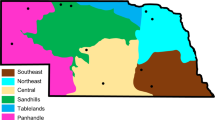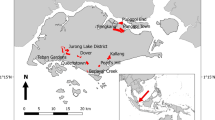Abstract
Many “natural” areas are exposed to military or recreational off-road vehicles. The interactive effects of different types of vehicular disturbance on vegetation have rarely been examined, and it has been proposed that some vegetation types are less susceptible to vehicular disturbance than others. At Fort Riley, Kansas, we experimentally tested how different plant community types changed after disturbance from an M1A1 Abrams tank driven at different speeds and turning angles during different seasons. The greatest vegetation change was observed because of driving in the spring in wet soils and the interaction of turning while driving fast (vegetation change was measured with Bray-Curtis dissimilarity). We found that less vegetation change occurred in communities with high amounts of native prairie vegetation than in communities with high amounts of introduced C3 grasses, which is the first experimental evidence we are aware of that suggests plant communities dominated by introduced C3 grasses changed more because of vehicular disturbance than communities dominated by native prairie grasses. We also found that vegetation changed linearly with vehicular disturbance intensity, suggesting that at least initially there was no catastrophic shift in vegetation beyond a certain disturbance intensity threshold. Overall, the intensity of vehicular disturbance appeared to play the greatest role in vegetation change, but the plant community type also played a strong role and this should be considered in land use planning. The reasons for greater vegetation change in introduced C3 grass dominated areas deserve further study.






Similar content being viewed by others
References
Althoff PS, Thien SJ (2005) Impact of M1A1 main battle tank disturbance on soil quality, invertebrates, and vegetation characteristics. Journal of Terramechanics 42:159–176
Anderson AB, Howard H, Ayers P, Butler C, Wu C, Woodford P, Otto C (2006) Soil property influence on military vehicle impacts. American Society of Agricultural and Biological Engineers, Portland, Oregon, USA: paper number 061183
Anderson AB, Palazzo AJ, Ayers PD, Fehmi JS, Shoop S, Sullivan P (2005) Assessing the impacts of military vehicle traffic on natural areas. Introduction to the special issue and review of the relevant military vehicle impact literature. Journal of Terramechanics 42:143–158
Braunack MV, Williams BG (1993) The effects of initial soil water content and vegetative cover on surface soil disturbance by tracked vehicles. Journal of Terramechanics 30:299–311
Bray JR, Curtis JT (1957) An ordination of the upland forest communities of southern Wisconsin. Ecological Monographs 27:325–349
Craine JM, Wedin DA, Chapin FS, Reich PB (2002) Relationship between the structure of root systems and resource use for 11 North American grassland plants. Plant Ecology 165:85–100
Dale V, Druckenbrod DL, Baskaran L, Aldridge M, Berry M, Garten C, Olsen L, Efroymson R, Washington-Allen R (2005) Vehicle impacts on the environment at different spatial scales: observations in west central Georgia, USA. Journal of Terramechanics 42:383–402
Debusk WF, Skulnick BL, Prenger JP, Reddy KR (2005) Response of soil organic carbon dynamics to disturbance from military training. Journal of Soil and Water Conservation 60:163–171
Foster JR, Ayers PD, Lombardi-Przybylowicz AM, Simmons K (2006) Initial effects of light armored vehicle use on grassland vegetation at Fort Lewis, Washington. Journal of Environmental Management 81:315–322
Garten CT Jr, Ashwood TL, Dale VH (2003) Effect of military training on indicators of soil quality at Fort Benning, Georgia. Ecological Indicators 3:171–179
Goldberg DE, Rajaniemi T, Gurevitch J, Stewart-Oaten A (1999) Empirical approaches to quantifying interaction intensity: Competition and facilitation along productivity gradients. Ecology 80:1118–1131
Great Plains Flora Association (1986) Flora of the Great Plains. University Press of Kansas, Lawrence, Kansas
Groffman PM, Baron JS, Blett T, Gold AJ, Goodman I, Gunderson LH, Levinson BM, Palmer MA, Paerl HW, Peterson GD, Poff NL, Rejeski DW, Reynolds JF, Turner MG, Weathers KC, Wiens J (2006) Ecological thresholds: The key to successful environmental management or an important concept with no practical application? Ecosystems 9:1–13
Halvorson JJ, McCool DK, King LG, Gatto LW (2001) Soil compaction and over-winter changes to tracked-vehicle ruts, Yakima Training Center, Washington. Journal of Terramechanics 38:133–151
Haugen LB, Ayers PD, Anderson AB (2003) Vehicle movement patterns and vegetative impacts during military training exercises. Journal of Terramechanics 40:83–95
Hayden BP (1998) Regional climate and the distribution of tallgrass prairie. Pages 19–34 In: Knapp AK, Briggs JM, Hartnett DC, Collins SL (eds) Grassland dynamics: Long-term ecological research in tallgrass prairie. Oxford, New York
Hedges LV, Gurevitch J, Curtis PS (1999) The meta-analysis of response ratios in experimental ecology. Ecology 80:1150–1156
Hirst RA, Pywell RF, Marrs RH, Putwain PD (2003) The resistance of a chalk grassland to disturbance. Journal of Applied Ecology 40:368–379
Hirst RA, Pywell RF, Putwain PD (2000) Assessing habitat disturbance using an historical perspective: The case of Salisbury Plain military training area. Journal of Environmental Management 60:181–193
Hobbs NT, Baker DL, Ellis JE, Swift DM, Green RA (1982) Energy- and nitrogen-based estimates of elk winter-range carrying capacity. Journal of Wildlife Management 46:12–21
Johnson FL (1982) Effects of tank training activities on botanical features at Fort Hood, Texas. The Southwestern Naturalist 27:309–314
Kaiser HF (1960) The application of electronic computers to factor analysis. Educational and psychological measurement 20:141–151
Knapp AK, Seastedt TR (1998) Grasslands, Konza Prairie, and long-term ecological research. In: Knapp AK, Briggs JM, Hartnett DC, Collins SL (eds) Grassland dynamics: Long-term ecological research in tallgrass prairie. Oxford, New York, pp 3–15
Kockelman WJ (1983) Introduction. In: Webb RH, Wilshire HG (eds) Environmental effects of off-road vehicles. Springer-Verlag, New York, USA, pp 1–11
Lamba PS, Ahlgren HL, Muckenhirn RJ (1949) Root growth of alfalfa, medium red clover, bromegrass, and timothy under various soil conditions. Agronomy Journal 41:451–458
Leis SA, Engle DM, DML Jr, Fehmi JS (2005) Effects of short- and long-term disturbance resulting from military maneuvers on vegetation and soils in a mixed prairie area. Environmental Management 36:849–861
Li Q, Ayers PD, Anderson AB (2007) Prediction of impacts of wheeled vehicles on terrain. Journal of Terramechanics 44:205–215
Littell RC, Stroup WW, Freund RJ (2002) SAS for linear models, 4th edition. SAS Institue Inc., Cary, NC, USA
Milchunas DG, Schulz KA, Shaw RB (2000) Plant community structure in relation to long-term disturbance by mechanized military maneuvers in a semiarid region. Environmental Management 25:525–539
NCDC, NOAA (2005) April 2005 Kansas Climatological Data from National Climatic Data Center, Thomas R. Karl director. Volume 119 (4)
Palazzo AJ, Jensen KB, Waldron BL, Cary TJ (2005) Effects of tank tracking on range grasses. Journal of Terramechanics 42:177–191
Payne GF, Foster JW, Leininger WC (1983) Vehicle impacts on northern Great Plains range vegetation. Journal of Range Management 36:327–331
Philippi TE, Dixon PM, Taylor BE (1998) Detecting trends in species composition. Ecological Applications 8:300–308
Quist MC, Fay PA, Guy CS, Knapp AK, Rubenstein BN (2003) Military training effects on terrestrial and aquatic communities on a grassland military installation. Ecological Applications 13:432–442
Scheffer M, Carpenter S, Foley JA, Folkes C, Walker B (2001) Catastrophic shifts in ecosystems. Nature 413:591–596
Schläpfer F., Schmid B (1999) Ecosystem effects of biodiversity: A classification of hypotheses and exploration of empirical results. Ecological Applications 9:893–912
Shaw RB, Diersing VE (1990) Tracked vehicle impacts on vegetation at the Pinon Canyon Maneuver Site, Colorado. Journal of Environmental Quality 19:234–243
Smith B, Wilson JB (1996) A consumer’s guide to evenness indices. Oikos 76:70–82
Sokal RR, Rohlf FJ (1995) Biometry, Third edition. W.H. Freeman and Company, New York
Stevens J (1996) Applied multivariate statistics for the social sciences. Lawrence Erlbaum Associates, Mahwah, NJ, USA
Suding KN, Gross KL (2006) The dynamic nature of ecological systems: Multiple states and restoration trajectories. In: Falk DA, Palmer MA, Zedler JB (eds) Foundations of restoration ecology. Island Press, USA pp. 190–209
Suding KN, Gross KL, Houseman GR (2004) Alternative states and positive feedbacks in restoration ecology. Trends in Ecology and Evolution 19:46–53
Tasser E, Mader M, Tappeiner U (2003) Effects of land use in alpine grasslands on the probability of landslides. Basic and Applied Ecology 4:271–280
Temperton VM, Hobbs RJ, Nuttle T, Halle S (eds) (2004) Assembly rules and restoration ecology: bridging the gap between theory and practice. Island Press, Washington, DC, USA
Vertegaal PJM (1989) Environmental impact of Dutch military activities. Environmental Conservation 16:54–64
Wang G, Gertner G, Anderson AB, Howard H, Gebhart D, Althoff D, Davis T, Woodford P (2007) Spatial variability and temporal dynamics analysis of soil erosion due to military land use activities: Uncertainty and implications for land management. Land Degradation and Development 18:519–542
Watts SE (1998) Short-term influence of tank tracks on vegetation and microphytic crusts in shrubsteppe habitat. Environmental Management 22:611–616
Weaver T, Dale D (1978) Trampling effects of hikers, motorcycles and horses in meadows and forests. Journal of Applied Ecology 15:451–457
Wilsey BJ, Polley HW (2006) Aboveground productivity and root-shoot allocation differ between native and introduced grass species. Oecologia 150:300–309
Wilson SD (1988) The effects of military tank traffic on prairie: A management model. Environmental Management 12:397–403
Yorks TP, West NE, Mueller RJ, Warren SD (1997) Toleration of traffic by vegetation: Life form conclusions and summary extracts from a comprehensive data base. Environmental Management 21:121–131
Acknowledgments
We thank Chris Otto and Phil Woodford for help with logistics at Fort Riley, Thuy Bui for field work, and Terence Yorks and two anonymous reviewers for comments. Funding was provided by a grant from the Upper Middle Mississippi Valley (UMMV) Cooperative Ecosystems Studies Unit (CESU) Agreement W9132T-06-2-0007.
Author information
Authors and Affiliations
Corresponding author
Rights and permissions
About this article
Cite this article
Dickson, T.L., Wilsey, B.J., Busby, R.R. et al. Grassland Plant Composition Alters Vehicular Disturbance Effects in Kansas, USA. Environmental Management 41, 676–684 (2008). https://doi.org/10.1007/s00267-007-9064-4
Published:
Issue Date:
DOI: https://doi.org/10.1007/s00267-007-9064-4




